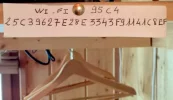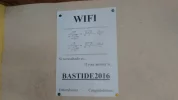- Time of past OR future Camino
- VdlP(2012) Madrid(2014)Frances(2015) VdlP(2016)
VdlP(2017)Madrid/Sanabres/Frances reverse(2018)
-
Remove ads on the forum by becoming a donating member. More here.
Search 74,075 Camino Questions
You are using an out of date browser. It may not display this or other websites correctly.
You should upgrade or use an alternative browser.
You should upgrade or use an alternative browser.
WIFI passwords on the Camino
- Thread starter Peregrinopaul
- Start date
-
- Tags
- phones/apps/gps/maps
3rd Edition. More content, training & pack guides avoid common mistakes, bed bugs etc
- Time of past OR future Camino
- VdlP(2012) Madrid(2014)Frances(2015) VdlP(2016)
VdlP(2017)Madrid/Sanabres/Frances reverse(2018)
I hope I’m not steering this thread off course, but I have to contrast this with my experience asking for the wifi key at a bar on the Frances in Spain. Despite my developing Spanish, I simply could not understand the barman’s reply, and I asked him to write it down. To his credit, and my intense embarrassment he did comply. He wrote; 1234567More like the code to a nuclear launch…!
- Time of past OR future Camino
- April/may 2022 SJPP to Santiago
Yes I know .. I am french .. it is ridiculous and makes you insane !!!Something off-beat.
June last year in France - I was often plagued by Wifi pastwords like this. In this instance think I admitted defeat! A sharp contrast to Spain where I found most passwords user-friendly.
This was a place I stayed on the Camino Littoral on the SW coast.
View attachment 76132
Ideal sleeping bag liner whether we want to add a thermal plus to our bag, or if we want to use it alone to sleep in shelters or hostels. Thanks to its mummy shape, it adapts perfectly to our body.
€46,-
€46,-
JamesVT
Active Member
- Time of past OR future Camino
- Camino Frances 2019
I encountered hopeless pass words like this in a few places in Spain. Often, servers would have memorized these crazy combinations of numbers and letters and would take my phone in hand and key the password in for me.Something off-beat.
June last year in France - I was often plagued by Wifi pastwords like this. In this instance think I admitted defeat! A sharp contrast to Spain where I found most passwords user-friendly.
This was a place I stayed on the Camino Littoral on the SW coast.
View attachment 76132
- Time of past OR future Camino
- 2024 Aragones, Madrid, Portugues Coastal
Could the reason for this is that many of the Gites in France are the the owner's private home and they use the same wifi signal? I have no idea but maybe.Something off-beat.
June last year in France - I was often plagued by Wifi pastwords like this. In this instance think I admitted defeat! A sharp contrast to Spain where I found most passwords user-friendly.
This was a place I stayed on the Camino Littoral on the SW coast.
View attachment 76132
DebR
Active Member
- Time of past OR future Camino
- Camino Frances, 2013, 14, 15, 17, 18, 19, 23
ISomething off-beat.
June last year in France - I was often plagued by Wifi pastwords like this. In this instance think I admitted defeat! A sharp contrast to Spain where I found most passwords user-friendly.
This was a place I stayed on the Camino Littoral on the SW coast.
View attachment 76132
 I loved this one in Foncebadón (zoom to above the bar). The fun part for me is going back at 18 month intervals and seeing how many places I automatically connect with previous passwords.
I loved this one in Foncebadón (zoom to above the bar). The fun part for me is going back at 18 month intervals and seeing how many places I automatically connect with previous passwords. Train for your next Camino on California's Santa Catalina Island March 16-19
- Time of past OR future Camino
- CF in spring and winter, Portugues, Sanabres: 2024
Something off-beat.
June last year in France - I was often plagued by Wifi pastwords like this. In this instance think I admitted defeat! A sharp contrast to Spain where I found most passwords user-friendly.
This was a place I stayed on the Camino Littoral on the SW coast.
View attachment 76132
My favorite was a bar in a small town that used the phone number for the local taxi as the WiFi code. He had a stack of the guy's cards on the bar and just handed them to anybody who asked for the password.
VeganCamino
Active Member
- Time of past OR future Camino
- Future Frances from Saint Jean Pied du Port to Burgos, starting in June.
Something off-beat.
June last year in France - I was often plagued by Wifi pastwords like this. In this instance think I admitted defeat! A sharp contrast to Spain where I found most passwords user-friendly.
This was a place I stayed on the Camino Littoral on the SW coast.
View attachment 76132
Pamplona Wi-Fi

- Time of past OR future Camino
- VdlP(2012) Madrid(2014)Frances(2015) VdlP(2016)
VdlP(2017)Madrid/Sanabres/Frances reverse(2018)
Oh man! You destroyed my France/Spain theory. But I still win: 26 to 20Pamplona Wi-Fi
Ideal sleeping bag liner whether we want to add a thermal plus to our bag, or if we want to use it alone to sleep in shelters or hostels. Thanks to its mummy shape, it adapts perfectly to our body.
€46,-
€46,-
DoughnutANZ
Ka whati te tai ka kai te tōreapango
- Time of past OR future Camino
- 2019, 2023, 2024, 2025, 2026, 2027 & 2028.
This is hexadecimal code. It is possible that these are random characters but I would be extremely cautious of this character stream. I would never enter these characters into my own devices.Something off-beat.
June last year in France - I was often plagued by Wifi pastwords like this. In this instance think I admitted defeat! A sharp contrast to Spain where I found most passwords user-friendly.
This was a place I stayed on the Camino Littoral on the SW coast.
View attachment 76132
- Time of past OR future Camino
- Us:Camino Frances, 2015 Me:Catalan/Aragonese, 2019
Each of the 16 characters 0-9A-F represents one of the patterns that can be made of 4 bits 0000-1111. These 4 bits are sometimes called a nibble (2 nibbles making up a byte). The 28 characters of that passcode thus encode a pattern of 112 bits kept in storage in 14 bytes (where each byte is composed of 8 bits).This is hexadecimal code. It is possible that these are random characters but I would be extremely cautious of this character stream. I would never enter these characters into my own devices.
A passcode of something like "mypassword123" also causes a storage of bits into bytes. Here though each letter is encoded as a pattern of 8 bits. For example, an uppercase L is represented in ASCII code by a byte of bits that can be represented by the two nibbles of 4C.
In each case the software is checking that the bits you enter exactly match the number and pattern of bits that have been encoded into the router by the manufacturer or overwritten by the owner of the router. Hopefully the owner has put in a easier to type passcode.
Last edited:
- Time of past OR future Camino
- Various 2014-19
Via Monastica 2022
Primitivo 2024
Sorry, @Doughnut NZ , but I don't follow. Can you please explain in simple language for computer dummies why not?This is hexadecimal code. It is possible that these are random characters but I would be extremely cautious of this character stream. I would never enter these characters into my own devices.
Ideal sleeping bag liner whether we want to add a thermal plus to our bag, or if we want to use it alone to sleep in shelters or hostels. Thanks to its mummy shape, it adapts perfectly to our body.
€46,-
€46,-
- Time of past OR future Camino
- Most years since 2012
As far as I understand, these are automatically-generated passwords that the computer system produces. The owner can choose to change them to an easier one, IF said owner finds out how to do so and wants to bother.Sorry, @Doughnut NZ , but I don't follow. Can you please explain in simple language for computer dummies why not?
- Time of past OR future Camino
- Various routes 2016 - 2024
They are the random passwords that come with the wifi routers, and most can be changed by the owner of the router.As far as I understand, these are automatically-generated passwords that the computer system produces.
DoughnutANZ
Ka whati te tai ka kai te tōreapango
- Time of past OR future Camino
- 2019, 2023, 2024, 2025, 2026, 2027 & 2028.
All computers talk in binary code and in the beginning, programmers had to load information (data and programs) into the first computers using banks of switches. Information that came out was read from banks of lights. Note that switches can be on and off and the same with lights and so binary code (zero or one) related directly to on and off.Sorry, @Doughnut NZ , but I don't follow. Can you please explain in simple language for computer dummies why not?
That was a bit tedious, slow and error prone and soon someone invented paper tape and cards with holes punched in them to speed up the process and at about the same time decided that while computers did need to communicate in binary code, humans did not need to do the same.
The early computers had various "word" lengths, a convenient grouping of binary codes. Initially, each computer manufacturer and even different models of computers had different word lengths. They could be grouped in twos, threes, fours, sixs, eights, tens, twelves, sixteens and even twenty-twos. Binary digits were grouped into "words" so that they could
be moved around within the computer using a single action for the word. This greatly sped up computer activity. However, with different word lengths there was no simple and common way of converting binary codes into a more human readable format.
As an example, a group of two binary digits could have four possible combinations. 00; 01; 10; and 11. To make these combinations more readable we could assign them the decimal digits 0; 1; 2 and 3. Similarly, with a grouping (word length) of 3 you could have eight different combinations and these combinations could then be assigned to the decimal digits 0 through 7.
During the early 1960's International Business Machines (IBM) was the dominant computer manufacturer and in 1963 they introduced a very successful range of computers that used 8 binary digit (also called 8 bits) bytes, with 4 bytes per word, giving a 32 bit word. This was the IBM System 360 range of computers.
Alongside the System 360 IBM introduced Extended Binary Coded Decimal Interchange Code (EBCDIC) and hexadecimal (base 16) number representation using the decimal digits 0 through 9 and A through F for the other 6 "digits".
As an aside, IBM wasn't the first computer company to use hexadecimal coded numbers in computers. Another company beat them to it but used u through z instead of A through F for the digits above 9. However, IBM's system won out and today the A to F representation is used almost universally.
Also base16 numbers (hexadecimal numbers) existed before IBM used them in their computers but IBM was the second (and dominant) computer manufacturer to use them. There is some disagreement about who first invented base16 number systems, some attribute it to a French wizard with eight fingers on each hand and others to a Swedish mathematician, see Wikipedia.
Hexadecimal numbers fit computers very well. It takes 4 bits (0000 through 1111) and so significantly shortens (and simplifies) computer input and output while also being a multiple of the 32 bit word used in the System 360. For example, 8BADF00D is much simpler (for humans) and more compact than 10001011101011011111000000001101.
Typically, hexadecimal numbers are written as couplets and so 8BADF00D would typically be written as 8B AD F0 0D.
Okay, that was a very long winded and perhaps interesting explanation of what hex(adecimal) numbers are but why did I react so strongly when I saw the WiFi password that was shown by the original poster?
Well, because hex numbers are so universal across computers and so close to the binary code that computers understand that it is possible for someone who knows what they are doing to write a program using just hexadecimal numbers. Bad operators (i.e. hackers) can use hexadecimal numbers and buffer overload vulnerabilities to do bad things to other people's computer devices.
Here is a very simple program fragment written in a random Assembler language (don't ask):
LDA A 80 04
ASR A
BCC FA
LDA A 80 05
AND A 7F
JMP C0 79
Here is the hexadecimal numbers produced by the Assembler that is capable of running on the computer that the assembly language is designed for:
B680044724FAB68005847F7EC079
If I enter this string into an input field that is vulnerable to buffer overflow on a computer that uses these operators then this program could run!
There were other long and complex WiFi passwords shown in later posts on this topic that are NOT made up of hexadecimal numbers. These other passwords are not a problem, just the first one posted.
As far as I am aware, NO manufacturer uses hexadecimal numbers for the default WiFi password.
Last edited:
The one from Galicia (the round) and the one from Castilla & Leon. Individually numbered and made by the same people that make the ones you see on your walk.
- Time of past OR future Camino
- Various 2014-19
Via Monastica 2022
Primitivo 2024
Wow, Doughnut NZ, thanks - now I know what some of the jargon means that I have never understood. And...
So the question immediately arises as to how to tell the difference between hex and just long crazy passwords.
It's this, right? Any PW with these digits and characters only - and I assume the characters are all in upper case and case-sensitive?:
Oyyyyyyyyyyyyyyyy. I get it.Bad operators (i.e. hackers) can use hexadecimal numbers and buffer overload vulnerabilities to do bad things to other people's computer devices.
So the question immediately arises as to how to tell the difference between hex and just long crazy passwords.
It's this, right? Any PW with these digits and characters only - and I assume the characters are all in upper case and case-sensitive?:
decimal digits 0 through 9 and A through F
DoughnutANZ
Ka whati te tai ka kai te tōreapango
- Time of past OR future Camino
- 2019, 2023, 2024, 2025, 2026, 2027 & 2028.
Yes, you are correct. Case does usually matter.Wow, Doughnut NZ, thanks - now I know what some of the jargon means that I have never understood. And...
Oyyyyyyyyyyyyyyyy. I get it.
So the question immediately arises as to how to tell the difference between hex and just long crazy passwords.
It's this, right? Any PW with these digits and characters only - and I assume the characters are all in upper case and case-sensitive?:
mark connolly
Active Member
- Time of past OR future Camino
- sept 2016 CF
sept 2017 Lourdes to SJPDP via Piemonte
SJPDP to SDC via CF
2019 CF (God willing)
Train for your next Camino on California's Santa Catalina Island March 16-19
❓How to ask a question
How to post a new question on the Camino Forum.
Most read last week in this forum
I saw a video with a rather harsh criticism of a small, municipal albergue on one of the less traveled caminos. They paid 9€. I thought: What does it cost a small municipality to renovate and keep...
I was hoping to do a walk over ninety days so I researched a long stay visa. This walk would have gone through four countries but the majority of the time would have been in France. So I applied...
"A complete guide to the world's greatest pilgrimage"[sic] by Sarah Baxter.
In a British newspaper, The Telegraph. A right wing daily that does print interesting articles and essays...
I've been trying to figure out how to use the Gronze app and as a first step I need to translate into English - I searched topics on the Forum, thought I found what I was looking for, and Yay! I...
My wife and I are planning to buy a house in the north-west of Spain for our retirement. Today, while scrolling through the ads, I noticed this: https://www.idealista.com/inmueble/106560131/...
Similar threads
- Replies
- 22
- Views
- 2K
- Replies
- 6
- Views
- 866
- Replies
- 9
- Views
- 2K
- Replies
- 18
- Views
- 1K
- Replies
- 2
- Views
- 754
❓How to ask a question
How to post a new question on the Camino Forum.
Most downloaded Resources
-
“All” Albergues on the Camino Frances in one pdf“All” Albergues on the Camino Frances in one pdf
- ivar
- Updated:
-
A selection of favorite albergues on the Camino FrancésFavorite Albergues along the Camino Frances
- Ton van Tilburg
- Updated:
-
Profile maps of all 34 stages of the Camino FrancesProfile maps of all 34 stages of the Camino Frances
- ivar
- Updated:

















